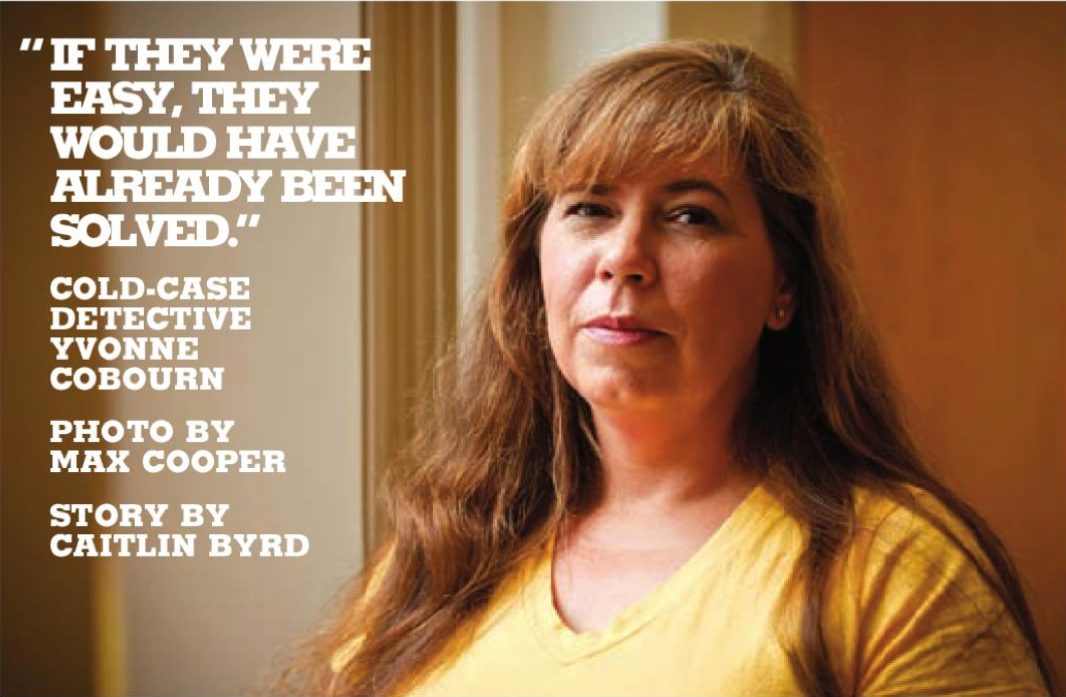
They know each case by name.
“Jake Burrell,” he recalls.
“Virginia Olson,” she adds.
“Glenn Zachery,” he replies.
“Zeke Penland in ’76 and Oscar Davis in ’77,” she says.
The two detectives continue their alternating cadence, exchanging nods and exasperated sighs after every name. For Kevin Taylor and Yvonne Cobourn, Asheville’s 24 cold cases are an all-too-familiar story. But the plots are not conventional: Cold cases don’t have endings. Instead they consist mostly of interviews, evidence and theories — and if they end in anything, it’s typically a question mark. By definition, a case becomes cold when all the leads have been exhausted.
“If they were easy, they would have already been solved,” stresses Cobourn. “But that challenge is what we embrace.”
The Asheville Police Department established its official Cold Case Unit in July 2008, and Cobourn and Taylor got the nod. Across the country, such entities seem to be the exception rather than the rule.
In a 2010 National Institute of Justice survey of cold-case investigations, researchers queried 5,000 police departments; 1,050 responded. Only 20 percent of those agencies had any protocol for cold cases, and even fewer (10 percent) reported having dedicated cold-case investigators like Cobourn and Taylor.
When the Asheville unit was created, these cases were the duo’s primary assignment. Nowadays, however, they must divide their time among active, cold and missing-person cases, working out of a second-floor office at police headquarters.
“That’s your Catch-22,” notes Cobourn. “That’s two detectives that are full-time; that’s two salaries that aren’t [contributing] toward that everyday caseload.”
“We don’t have the luxury of doing cold cases full time anymore.” Taylor adds. “We’re working on them on our own initiative, with time being the key factor.”
Methodical work
The last case they solved was the Sandra Proffitt homicide. That was more than three years ago, and it took the detectives about six months to get a confession. Proffitt was murdered Jan. 17, 1990, in her Deaverview apartment. Nineteen years later, Cobourn and Taylor charged her then boyfriend, Terry Spivey, with second-degree murder. More importantly, they were able to get a conviction, which happens in only about 1 percent of cold cases nationwide.
Even when police “clear” (solve) a cold case, it doesn’t always lead to an arrest. The prime suspect, for example, could be missing, incarcerated or dead. But when someone is convicted of a crime — cold or otherwise — the case is closed.
Still, cold cases don’t get solved by accident, and the process is nothing like what you see on TV. “I wish I could say that every day working on a cold case is filled with excitement and drama and,” here Cobourn pauses for effect, “is sexy.”
“It’s not,” Taylor interjects. “It’s very methodical.”
Getting Spivey’s crucial confession, for example, required a rigorous re-examination of all the case’s files, including documents, photos, drawings and notes. And though all such materials have been scanned into the department’s working database, these cases also still reside in big 3- to 5-inch binders that detectives will thumb through from time to time.
Those notes may help them consider cases with a fresh approach and an open mind. But some aspects of such investigations remain pretty standard. From former detectives to witnesses, Cobourn and Taylor try to interview everyone involved — even those who are listed in the case files but were never brought in for questioning.
“You never know when that person is going to give you some small key or insightful information that can start pointing you in a totally different direction,” says Cobourn. It’s also one of the few instances when the passage of time may work in law enforcement’s favor. “Relationships change, Taylor explains. “People that were close 20 years ago may not be so close anymore.”
Geographic distance can also be a factor. “Once upon a time, you would live out your entire life within 50 miles of where you were born,” notes Cobourn. “Now, it’s nothing for people to jump up and move across the country without any thought.”
Deteriorating evidence
But even independent of any idea, theory or lead, time itself can become a formidable obstacle when it comes to evidence. Before switching to investigations, Cobourn spent a year in the APD’s Forensics Department.
“Whenever you start pulling evidence out to send to the labs and it’s older than 20 years, how things were packaged and kept was different then, because we didn’t have the knowledge that we have now about biological fluids and things of that nature,” Cobourn reveals.
Accordingly, much of the evidence in Asheville’s cold cases has since been repackaged to today’s standards to help stave off deterioration. If biological evidence such as blood, semen and saliva samples isn’t kept in a dry environment protected from sunlight and ultraviolet radiation, the unique DNA profile could be compromised. This makes it difficult for forensic labs to find a match in CODIS (the FBI’s Combined DNA Index System database). Only state labs can submit DNA profiles into CODIS.
And for local law-enforcement agencies, submitting cold-case evidence to state forensic labs can pose a number of problems. Forensic science is constantly evolving, with new techniques introduced every year, but thanks to tight budgets and other issues, they’re not filtering down to the state or even federal labs, says Cobourn.
“We have evidence in these cases that could potentially solve the case if we had the money to send the evidence to these private labs,” she laments.
Financial constraints aside, there’s also a logjam at the State Bureau of Investigation labs. “We’ve got cases where we feel like we’ve got some good leads and re-submit evidence to the lab, and we’re waiting 12 to 14 months to hear anything back,” says Taylor.
“If not longer,” adds Cobourn.
“But in the eyes of the state lab, it’s a cold case: They think, ‘What’s the hurry?’” continues Taylor. “So it goes to the bottom of the totem pole, so to speak.”
Meanwhile, the Asheville team has no choice but to wait patiently and keep investigating and researching.
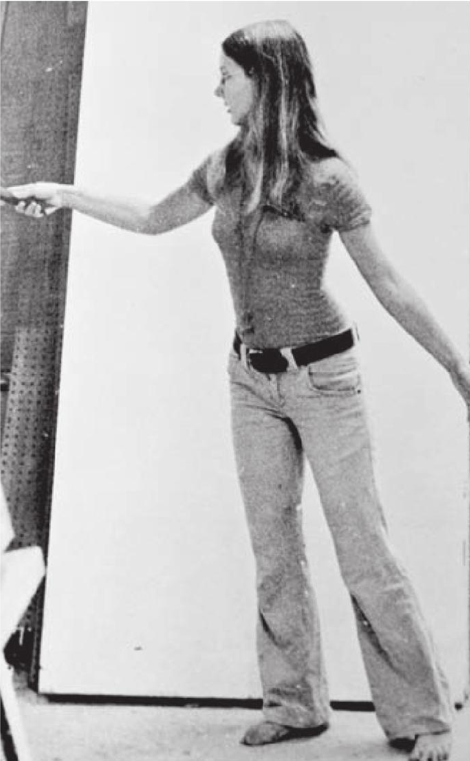

For the families
Still, it’s not the kind of work the detectives can simply leave at their respective desks. It follows them home — sometimes in unexpected ways.
“I might just be going to a place by coincidence where the crime occurred, and then I just start thinking about it,” Taylor reveals.
“Or driving by it,” says Cobourn. “With some of the cases that I have, I live in the geographical area, so I drive by them on my way to work and on my way home.
But it’s not just the crime scenes that embed these cold cases in the lives of the detectives trying to solve them. For Cobourn and Taylor, the families are a key motivation to keep going.
“If we’re not doing it, nobody else is going to be doing it, and those families are still going to be waiting for answers,” says Taylor. “We, unfortunately, can’t always give them the answers they want, or the outcome, but at least we’re making the effort.”
Cobourn also works closely with Families Pursuing Justice. Founded in 2009 by people affected by cold cases, the local nonprofit works with law enforcement to give families emotional support while they wait for justice for their loved ones. The group also tries to raise money to help continue the investigations.
“It’s not about patting ourselves on the back: It’s about the families, and it’s about the victims,” Cobourn asserts.
Denise Vlahakis is one of the nonprofit’s founding members. After leaving work at the Hendersonville Road Wal-Mart at 9 p.m., her son, Zebb Quinn, went missing on Jan. 2, 2000. Two weeks later, authorities found his light-blue Mazda Protege in the parking lot of the Little Pigs Barbecue restaurant; a pair of lips with two exclamation marks was drawn on the rear window in lipstick, and inside the vehicle was a live black Labrador puppy.
The case garnered national attention when it aired on the Investigation Discovery Channel show “Disappeared” recently. But even without that increased exposure, Cobourn says she feels a strong attachment to this high-profile case and to Vlahakis as a mother.
“I have kids, and I’m not sure, if I was in her shoes, if I’d even be able to breathe. So I kind of take that approach to Zebb,” confesses Cobourn.
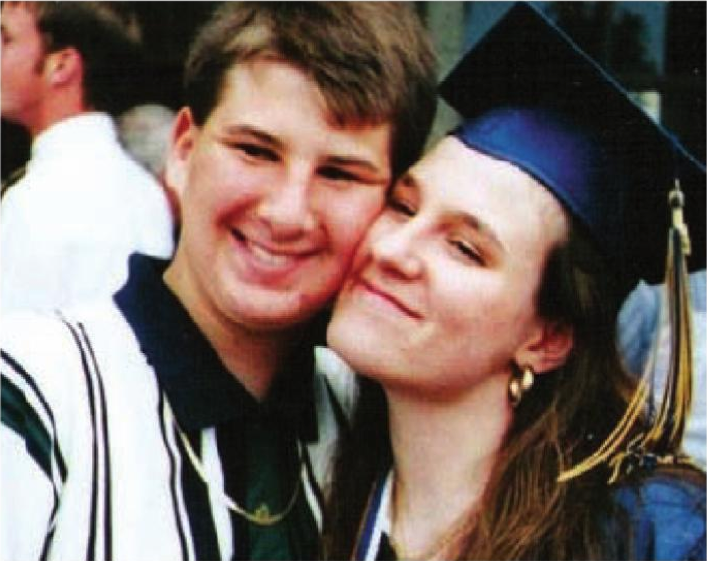
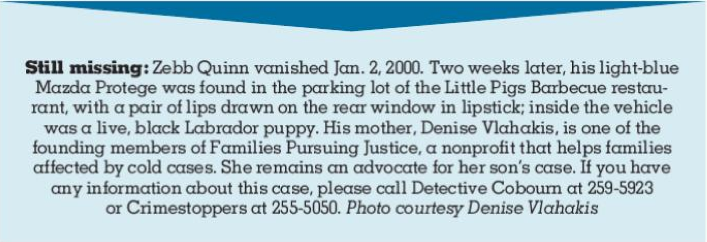
An abiding passion
Taylor, who’s worked in the APD’s Criminal Investigations Department since 1994, has a different style. “She’s a little more outgoing than I am,” he remarks.
Cobourn, an investigator since 2006, agrees. “Where I’m pretty much like full-steam-ahead, Kevin will say no. Where I may want to charge forward, Kevin will slow me down.” She pauses. “He knows when to slow down, whereas I’m still learning that boundary.”
Nonetheless, the two share an abiding passion for what they do. “I always aspired to work these types of cases,” Taylor explains. “I enjoy working other cases as well, but I find the challenge of these to be the most intriguing.”
It isn’t glamorous. Rather than riding around in a squad car, these detectives spend most of their time ruminating over cases, their two desks separated by a little blue rug.
“It may mean months of going through cell-phone bills. It may mean weeks on this computer trying to find a witness that was never interviewed,” Cobourn emphasizes. “I spend a lot of time sitting right here.”
Currently, the pair are investigating about six cold cases.
“There are those days when it’s like you look at it and you look at it and you still think you’ve missed something,” Cobourn explains. “It’s like I have lived, slept, eaten and breathed some of these cases,” she says softly.
Taylor nods. Glancing at his partner in solving crimes, he says in a low echo, “I’m always thinking about one of them.”
If you have any information about these and other cold cases, call Det. Cobourn at (828) 259-5923 or Crimestoppers at 255-5050.
— Caitlin Byrd can be reached at cbyrd@mountainx.com, or at 251-1333, ext. 140.



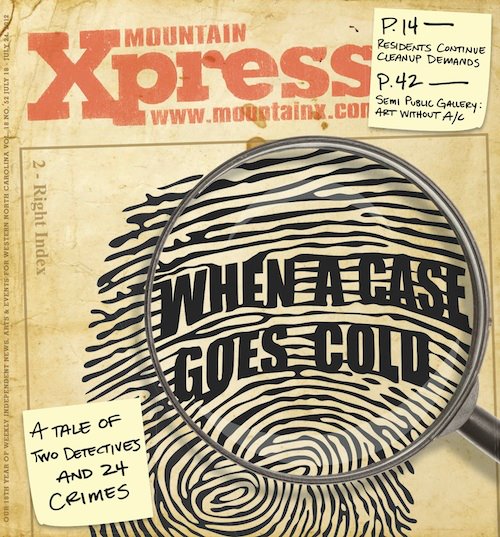
Easily one of the most informing and well written Xpress articles I have ever read. Kudos!
great story! It is a very tough job
Thank you, Justin and Tom! I really appreciate the positive feedback.
I saw the Disappeared episode featuring Zebb Quinn a few months ago and I haven’t been able to stop thinking about him. It seems like there are some very likely suspects just no concrete evidence to link them to his disappearance. I hope one day his case will be solved, his family deserves to know the truth. God bless you Zebb, wherever you are.
why was the lipstick not checked for mistys dna also the dog found in zebs car, why didn’t the detectives check the house or cars of misty and her boyfriend for dog hair that most likely would have matched.
There’s a reason Kevin Taylor pushes Cobourn to slow down. And there’s a reason Kevin Taylor adopted that black lab Quinn’s car. And there’s a reason those lips were sealed. The lipstick lips were sealed on Quinn’s car. And there’s a reason Kevin Taylor has worked for the Asheville Police Department since his date of hire on July 4, 1987. And there’s a reason Kevin Taylor still worked for the Asheville Police Department in 2012 when this article was written. I thought police officers were eligible for retirement after 25 or 30 years. Kevin Taylor would have served 25 years on July 4, 2012. This case might be solved when Kevin Taylor and Cobourn move into retirement. Someone needs to ask Cobourn how she feels about an inside job when it comes to investigating homicides.